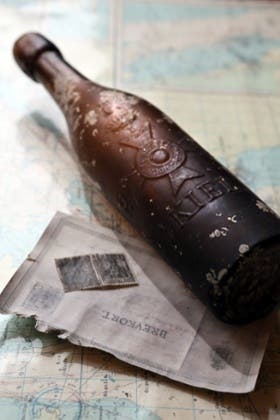
Last week, the story of a German fisherman made front news after he found a message in bottle floating in the Baltic Sea for nearly 101 years. What’s more, despite most of the text written was undecipherable, researchers at the Hamburg Museum were able to find the sender’s name and deliver the message to his grand-daughter. An incredible story, the kind you don’t hear every day no doubt, but how was this possible and what can we learn from this? Better way said: what can you do for your message in a bottle to last longer and eventually reach a ship in case your stuck on a deserted island? You wouldn’t want your only ink and paper topple to the bottom of the sea the moment you throw it. Read on.
The scribbled message pulled out of the Baltic was made on a postcard dated May 17, 1913. Researchers were able to determine based on the address that it was 20-year-old baker’s son Richard Platz who threw the bottle in the Baltic while on a hike with a nature appreciation group in 1913. Platz died in 1946, but a genealogist was able to locate his 62-year-old granddaughter, Angela Erdmann, in Berlin, which greeted the message with much emotion.
So, how did this bottle survive for more than 100 years in the Baltic Sea? There are storms, ebbs, marine life, all sorts of conditions that aren’t quite suitable to keep a beer bottle afloat. Popular Mechanics asked Thomas Peacock, professor of mechanical engineering and fluid dynamics at MIT about this and, wouldn’t you know it, the short answer was “chance”. But that’s not all to it; were the bottle thrown in waters in the Atlantic or the Pacific it may have never been retrieved, as conditions there are far more unpredictable.
“In the middle of the Pacific, for example, you have a mixture of flow structures,” Peacock says. “You can have consistent currents, but you can also have big eddies and vortices.”
The Baltic Sea is a relatively calm body of water, whose currents flow a neat, counterclockwise pattern at a relaxed rate of 1 cm per second. “It looks like it would take a bottle about three years to circulate around the Baltic,” Peacock says. “So we’re basically saying that, over 100 years, it would have made something like 30 trips.”
The gist here is that if you’re to plan a trip at sea, might as well make it the Baltic Sea, since it’s apparently the safest place to send a message in bottle … and wait 100 years after. But that’s not all there is to it, of course. Location may be important, but it’s not everything. For instance, the ink and paper Platz used in 1913 were fairly standard for the time, but he did used a black beer bottle and layered the message with the writing inward. This protected the writings from the solar elements, which would have surely degraded the message on the paper to further ill recognition.
In these many years, however, there’s also a lot of organic life sprouting on the bottle. This is another factor that needs to be consider, one that unfortunately is subjected to chance. “When we put any equipment in the ocean, life grows on it quite voraciously,” says David Holland, professor of mathematics and oceanography at New York University’s Courant Institute of Mathematical Sciences. “In the case of a beer bottle, whether life makes it sink or float would depend on whether the life form is buoyant or not.”


